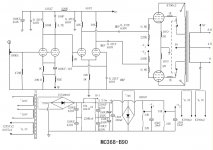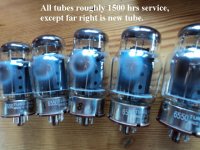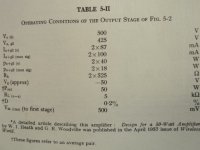Will i be able to measure Bias voltage across cathode resistor 10R/5W ?
This voltage should be around 1V for KT88 meaning 100mA Bias current?
I mean by doing this i avoid from measuring directly on High Voltages (Do`nt like)
I don't know what your plate voltage is but if it is anything over 400V, 100mA of plate current is going to melt most current production KT88 before your very eyes.
I would recommend something like 75mA up to about 450V, and somewhat lower at 500V for best longevity.
Yes you can measure the bias across a resistor in the cathode circuit, this of course is combined plate and screen grid current which is fine, and will give you an accurate picture of the combined plate and screen dissipation as long as you know the plate voltage.
I don't know what your plate voltage is but if it is anything over 400V, 100mA of plate current is going to melt most current production KT88 before your very eyes.
I would recommend something like 75mA up to about 450V, and somewhat lower at 500V for best longevity.
Yes you can measure the bias across a resistor in the cathode circuit, this of course is combined plate and screen grid current which is fine, and will give you an accurate picture of the combined plate and screen dissipation as long as you know the plate voltage.
Thanks for Your reply,
So 75mA means i will measure 750mV across my 10R/5W resistor on Pin 8 (Cathode).I could then adjust V1 and V2 accordingly?
I forgot to mention that i am using scematic i posted earlier in my post.
Attachments
Thanks for Your reply,
So 75mA means i will measure 750mV across my 10R/5W resistor on Pin 8 (Cathode).I could then adjust V1 and V2 accordingly?
I forgot to mention that i am using scematic i posted earlier in my post.
I'm assuming that your plate supply is somewhat over 500V so I would say that 70mA would be safer for use with KT88 at these voltages. You will measure 700mV across the 10R/5W resistor in the cathode circuit of each tube, and yes you would adjust V1 and V2 accordingly.
I should have realized that it was that earlier schematic, but I neglected to go back and look.
One other thing is that not all KT88 are created equal, and some will safely dissipate more than others despite what the specification sheets say. I have had trouble with ones from just about any maker you can think of. Observe very closely for the first hundred hours or so that they are not developing red spots on the plate.
The Genelex reissues are supposedly amongst the best sounding and most rugged of these types. I've had my share of problems with both JJ and EH branded KT88. I have not tried the Svetlana SPb manufactured KT88, but have heard from reputable sources that it is not the best sounding choice. IMLE the JJ KT88 sounds very good and may be reliable if you get ones that have been sorted, matched and burned in. I have no experience at all with current Shuguang production. As always YMMV...
I'm assuming that your plate supply is somewhat over 500V so I would say that 70mA would be safer for use with KT88 at these voltages. You will measure 700mV across the 10R/5W resistor in the cathode circuit of each tube, and yes you would adjust V1 and V2 accordingly.
I should have realized that it was that earlier schematic, but I neglected to go back and look.
One other thing is that not all KT88 are created equal, and some will safely dissipate more than others despite what the specification sheets say. I have had trouble with ones from just about any maker you can think of. Observe very closely for the first hundred hours or so that they are not developing red spots on the plate.
The Genelex reissues are supposedly amongst the best sounding and most rugged of these types. I've had my share of problems with both JJ and EH branded KT88. I have not tried the Svetlana SPb manufactured KT88, but have heard from reputable sources that it is not the best sounding choice. IMLE the JJ KT88 sounds very good and may be reliable if you get ones that have been sorted, matched and burned in. I have no experience at all with current Shuguang production. As always YMMV...
Thanks again for Your Quick Reply.
I got some matched "C" tubes(2 matched pairs) i want to try instead of KT90 EH.What is Your suggest about the 220K grid resistor they talked about earlier in this post? Is it more safe to change it to a 100k res when using
KT88 or can i keep it with 220k.
Thanks again for Your Quick Reply.
I got some matched "C" tubes(2 matched pairs) i want to try instead of KT90 EH.What is Your suggest about the 220K grid resistor they talked about earlier in this post? Is it more safe to change it to a 100k res when using
KT88 or can i keep it with 220k.
I would reduce the value of the 220K resistors to 100K if possible or as close as you can get to it without compromising the sound of your amplifier. I've used 150K resistors without issue, but I wouldn't go any higher than this, and 100K are preferable. YMMV..
Will i be able to measure Bias voltage across cathode resistor 10R/5W ?
This voltage should be around 1V for KT88 meaning 100mA Bias current?
I mean by doing this i avoid from measuring directly on High Voltages (Do`nt like)
I believe your amp runs at 500V ???.......at 100mA bias for KT88's is dangerously high, the tubes will be glowin' orange .....enough to grill a chicken. Increase neg bias volts to give around 50-60mA per tube and no higher. Once you set the quiescent current, multiply that by the anode voltage and one roughly gets the tube dissipation. 30-40W for new build KT88's is enough otherwise they will have a very short life.
V/R=I ...Ohms law. You know what R is..It's as simple as that.
richy
Funny, I was using one as the pass element in the power supply to my phono stage, running at 70mA with 250V across it it lasted barely two years. Needless to say I won't buy any more, in fact I am now running a vintage GE 6550A in that socket.. The reissue died somewhat noisily (lots of gain in the stages it powered) no evidence of electrical damage, but it developed an internal rattle which makes me think that some weld somewhere failed..
I've gotton back to New Sensor on similiar issues......I may never get a reply but will inform if and when something comes through.
A pic enclosed of some N Edit 6550 short life grey looking sick getters. IMO not worth paying for. The question is what to do with all those (100's) in my MI amps. A car-like recall ?
richy
Attachments
I've gotton back to New Sensor on similiar issues......I may never get a reply but will inform if and when something comes through.
A pic enclosed of some N Edit 6550 short life grey looking sick getters. IMO not worth paying for. The question is what to do with all those (100's) in my MI amps. A car-like recall ?
richy
Looks like they weren't pumped down all that well during production and perhaps the plates and other elements out gassed during operation? I've seen vintage ones that looked like this at about 10K hours of operation...
EH KT88 Firebottles
Your experience is the same as mine, Kevin. I am running some ASL Hurricanes so need 16 power tubes. A good many of the EH KT-88s I bought went into runaway mode and I caught all of them, save one, which blasted out resistors and the tube socket as well! I am always checking the bias so as to catch any more runaways before any real damage is done. I have heard that the latest Shuguangs sound good and are reliable. Not sure but at least hope it will be some time before I have to retube. It gets a little pricey with 16 tubes needed!
I'm assuming that your plate supply is somewhat over 500V so I would say that 70mA would be safer for use with KT88 at these voltages. You will measure 700mV across the 10R/5W resistor in the cathode circuit of each tube, and yes you would adjust V1 and V2 accordingly.
I should have realized that it was that earlier schematic, but I neglected to go back and look.
One other thing is that not all KT88 are created equal, and some will safely dissipate more than others despite what the specification sheets say. I have had trouble with ones from just about any maker you can think of. Observe very closely for the first hundred hours or so that they are not developing red spots on the plate.
The Genelex reissues are supposedly amongst the best sounding and most rugged of these types. I've had my share of problems with both JJ and EH branded KT88. I have not tried the Svetlana SPb manufactured KT88, but have heard from reputable sources that it is not the best sounding choice. IMLE the JJ KT88 sounds very good and may be reliable if you get ones that have been sorted, matched and burned in. I have no experience at all with current Shuguang production. As always YMMV...
Your experience is the same as mine, Kevin. I am running some ASL Hurricanes so need 16 power tubes. A good many of the EH KT-88s I bought went into runaway mode and I caught all of them, save one, which blasted out resistors and the tube socket as well! I am always checking the bias so as to catch any more runaways before any real damage is done. I have heard that the latest Shuguangs sound good and are reliable. Not sure but at least hope it will be some time before I have to retube. It gets a little pricey with 16 tubes needed!
Here is scematic with KT90.
Is it 33k at V1 and V2 ? for Bias adjustment?
What will readings be with KT88 ?
What is the watt tolerance for Grid resistor (220K) for this specific amplifier
according to this scematic?
I have at hand 150K 2Watt. Will they be fine?
What is the watt tolerance for Grid resistor (220K) for this specific amplifier
according to this scematic?
I have at hand 150K 2Watt. Will they be fine?
Two watt resistors will work just fine, all you would really need is a 1/2W type. Don't use metal oxide or carbon film types as they aren't the most linear types out there.
I believe your amp runs at 500V ???.......at 100mA bias for KT88's is dangerously high, the tubes will be glowin' orange .....enough to grill a chicken. Increase neg bias volts to give around 50-60mA per tube and no higher. Once you set the quiescent current, multiply that by the anode voltage and one roughly gets the tube dissipation. 30-40W for new build KT88's is enough otherwise they will have a very short life.
V/R=I ...Ohms law. You know what R is..It's as simple as that.
richy
Rich, the GEC 88-50 cct has 50V on its 525 ohm cathode resistors which gives, 95.2mA idle current (cathode bias). does this indicate a problem with high current?
cheers
Rich, the GEC 88-50 cct has 50V on its 525 ohm cathode resistors which gives, 95.2mA idle current (cathode bias). does this indicate a problem with high current?
cheers
At that plate voltage( 500V ), yes it does. At 400V of B+ it would be tolerable if the tube can make the ratings usually published for KT88's.
cheers,
Douglas
Enclosed in pic are the ratings for the original KT88-50 amp. This amp used the MOV generic KT88 which was ultimately more longer lasting than todays variants.
Using JJ'KT88's also bias with less and will run hotter.
I know the cathode resistors are as you stated, but todays tubes aren't really replicas of the "way they were made" reliability etc. For autobias I'm tempted to use a 560R and with fixed bias go around 50-60mA quiescent on each.
Give'em a chance.
richy
Using JJ'KT88's also bias with less and will run hotter.
I know the cathode resistors are as you stated, but todays tubes aren't really replicas of the "way they were made" reliability etc. For autobias I'm tempted to use a 560R and with fixed bias go around 50-60mA quiescent on each.
Give'em a chance.
richy
Attachments
Hi Again,
Now amp is adjusted (BIAS) but i`m not satisfied with result.
The tubes i changed is KT90 to a matched pairs of KT88.
These have a value stamped on them: 47 on one pair and 52
on the other pair.I putted the pair with 47 on Left side and
the 52`s on Right Channel.I adjusted then Bias with this cables :
Tube amp bias test probe 6l6 el34 kt88 or 6bq5 el84 - eBay (item 290531020309 end time Apr-05-11 20:34:06 PDT)
Left side measures 0,66V and Right side measures 0,62V.
After around 10-15minutes of settling time.
But the right side is not sounding ok, it is disturbed in midrange/bass.
I`m not sure if i can turn Bias further more up to eg. 0,75V ?
I also recognice sound turns ok for around 1-2 seconds when turning power Off! Sound goes higher and without distortion during this shut off time..Does it mean Bias is still to low and needs another adjustment?
Now amp is adjusted (BIAS) but i`m not satisfied with result.
The tubes i changed is KT90 to a matched pairs of KT88.
These have a value stamped on them: 47 on one pair and 52
on the other pair.I putted the pair with 47 on Left side and
the 52`s on Right Channel.I adjusted then Bias with this cables :
Tube amp bias test probe 6l6 el34 kt88 or 6bq5 el84 - eBay (item 290531020309 end time Apr-05-11 20:34:06 PDT)
Left side measures 0,66V and Right side measures 0,62V.
After around 10-15minutes of settling time.
But the right side is not sounding ok, it is disturbed in midrange/bass.
I`m not sure if i can turn Bias further more up to eg. 0,75V ?
I also recognice sound turns ok for around 1-2 seconds when turning power Off! Sound goes higher and without distortion during this shut off time..Does it mean Bias is still to low and needs another adjustment?
I don't know what your plate voltage is but if it is anything over 400V, 100mA of plate current is going to melt most current production KT88 before your very eyes.
I would recommend something like 75mA up to about 450V, and somewhat lower at 500V for best longevity.
Yes you can measure the bias across a resistor in the cathode circuit, this of course is combined plate and screen grid current which is fine, and will give you an accurate picture of the combined plate and screen dissipation as long as you know the plate voltage.
We need to know what power levels you are measuring at. In fixed bias I've used tubes with large gm variations without effecting sound quality. Remember setting Iquies sets the position on loadline and is nearly always approximate, the AC gain (gm of each tube) will determine the rated anode+ screen current at signal power in an AB stage. As Kevinkr mentions set 75mA, the full signal power will be roughly 110-130mA depending on the degree of gm matching. I can never detect the difference in quality as global nfb does an excellent job of correction.
You mention suddenly sounds good when turning amp off......I wonder if the output stage triode/pentode switch is switching properly on both halves. Those Jap mini toggle swiches are notorious for poor contacts.
richy
You mention suddenly sounds good when turning amp off......I wonder if the output stage triode/pentode switch is switching properly on both halves. Those Jap mini toggle swiches are notorious for poor contacts.
richy
Thanks Richy!
I will check the switch.
Is there any other "parts" i should replace in this chinese amp
It`s an Ming Da amplifier so might i should change caps too?
Thanks Again.
I will check the switch.
Is there any other "parts" i should replace in this chinese amp
It`s an Ming Da amplifier so might i should change caps too?
Thanks Again.
We need to know what power levels you are measuring at. In fixed bias I've used tubes with large gm variations without effecting sound quality. Remember setting Iquies sets the position on loadline and is nearly always approximate, the AC gain (gm of each tube) will determine the rated anode+ screen current at signal power in an AB stage. As Kevinkr mentions set 75mA, the full signal power will be roughly 110-130mA depending on the degree of gm matching. I can never detect the difference in quality as global nfb does an excellent job of correction.
You mention suddenly sounds good when turning amp off......I wonder if the output stage triode/pentode switch is switching properly on both halves. Those Jap mini toggle swiches are notorious for poor contacts.
richy
- Status
- This old topic is closed. If you want to reopen this topic, contact a moderator using the "Report Post" button.
- Home
- Amplifiers
- Tubes / Valves
- From KT90 to KT88


